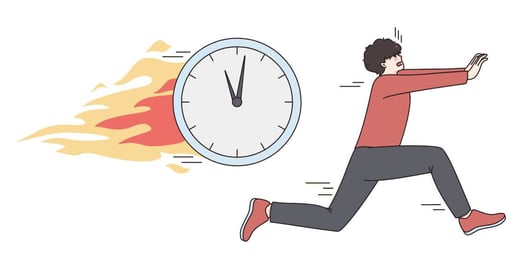Finding clients can be challenging—especially if you're just starting out—so why would you want to let them go?
Well, there are a couple of reasons, like if the client makes a lot of unrealistic demands or constantly changes their mind. But that doesn't make it easier—especially if it will create a significant financial hit.
Sometimes, it’s better to say goodbye—both for the growth of your business and your peace of mind.
So, how do you do it right? What are the signs that it is time to cut ties with a client?
Below, we discuss the telltale signs and the best ways to end a client relationship.
Why It's Critical to Know When to Cut Ties
It's important to recognize when it's time to end a client relationship. It can be the difference between growing your business or getting stuck in an endless cycle of stress, anxiety, and burnout. Sure, letting go of a client who contributes X amount to your monthly income will initially hurt, but the long-term benefits outweigh the short-term pain.
Consider a client that constantly makes late payments. Okay, they will eventually pay you. But at what cost? You're spending precious time chasing down payments, which eats your time, energy, and sanity.
It is also vital because, as a business owner, knowing when to walk away is critical for your growth. So, measure your business performance, and ask yourself, "Is this client worth my time and effort?
6 Signs It's Best to Cut Ties With a Client
Here are six indicators that suggest it might be time to part ways with a client;
1. Consistent Late Payments
One thing you should never compromise on is getting paid on time. Late payments can disrupt your cash flow and cause considerable inconvenience.
It can also demotivate you. If you continuously have to chase clients for payments, it can affect your productivity. Imagine putting in all that effort for no pay.

That's why you must have a system that ensures clients pay on time. Some measures include:
- Set clear payment terms: Make sure your contracts and invoices clarify when payment is due. You can specify that payment is due upon receipt of the invoice, within a certain number of days, or according to another schedule that works for both parties.
- Require a deposit or advance: Particularly for large projects or with new clients, it can be helpful to require a deposit or advance payment. This can help ensure that the client is committed to the project. Also, you are paid for at least part of your work upfront.
- Establish late payment penalties: Make it clear in your contracts that late payments incur a fee. This can encourage clients to pay on time.
- Use a centralized data system: A unified data system can be extremely useful for managing client payments. This platform can automate invoicing and payment reminders, making it easier to track who has paid and who hasn't. You can also use your system to track client contact information, project details, and other relevant data.
If a client still pays late despite these efforts, it is best to reconsider the relationship.
You can also take advantage of tools like a tax deduction cheat sheet to maximize your business's financial efficiency. In addition to providing clarity on tax-deductible business expenses, a tax deduction cheat sheet equips you with valuable financial knowledge that can assist you when making decisions about cutting ties with clients. Understanding your deductible expenses can help you assess the financial implications of ending a client relationship, ensuring that you consider the potential impact on your overall tax obligations and financial efficiency.
Read More: How to Collect Money from Clients Who Won’t Pay
2. Poor Communication
The most successful projects are the product of successful collaborations between different parties. When you work with a client, you want to make sure that you have communication flowing both ways.
But some clients make it really hard. Several reasons can account for this. Maybe, you're also serving a client with a lean team, where people multitask. Or they are just really bad at communication.
Whichever way, if a client is persistently difficult to get in touch with or unclear about their expectations or feedback, it can cause unnecessary stress and confusion. The job will also look sloppy, and the client will blame you.
A remedy is to make communication clear, easy, and accessible. Use tools like cloud data sharing and project management softwares or enable branded portals for your clients to make it as easy as possible to access the necessary information and keep each other updated.
However, even with these measures, sometimes, your efforts won't pay off. So, it's better to cut ties with the client at this stage.
Read More: Client Communication: 8 Actionable Tips
3. Consistent Added Scope of Work
Another reason to end your relationship with a client is when they continually add new tasks without altering the budget or schedule.
While it's normal for clients to request changes or additions to a project, it becomes problematic when they do so without acknowledging the impact on the original agreement. This can lead to overworking, missed deadlines, and, ultimately, dissatisfaction for both parties.

As a professional, you should be able to communicate the need for adjustments or renegotiation of terms. However, it may be time to part ways if the client is unwilling to cooperate. Remember, your time and expertise are valuable and deserve fair compensation.
4. Unreasonable Requests
It can be frustrating and time-consuming if a client consistently asks for things beyond the scope of the project or outside of your area of expertise.
While being flexible and accommodating is important, setting boundaries and communicating your limitations is equally critical.
But things like expecting you to immediately respond to emails or phone calls, demanding excessive revisions without additional payment, or expecting work to be completed outside the agreed-upon scope without further compensation are unacceptable.
If a client is making unreasonable requests that cause stress or compromise the quality of your work, it may be time to end your client relationship. Remember, you can say no and protect your time and energy.
5. Low Budget
There's nothing wrong with taking on small-budget clients. Heck! Most of us started by accepting low-paying jobs. You know, to get that experience and portfolio. But as you gain more experience, your time and expertise become more valuable.
Let's say you serve finance clients. After a few years, you upgrade your financial services experience by getting new software and a few certifications. That upskilling means you expect a higher pay rate.
You may need to leave a client who cannot meet your new fee. After all, the point of upskilling is to increase your earnings.
Pro tip: Make sure to add specific and relevant objectives in your resume to provide a clearer understanding of your target market for potential clients.
6. Incompatibility
Sometimes, despite your best efforts, you and a client don't click. Maybe their communication style is too aggressive, or they have unrealistic expectations that you can't meet.
Perhaps their values clash with yours or are simply difficult to work with. Whatever the reason, it's time to reevaluate the relationship if you dread every interaction with a client.

One of the reasons you started your own business is to choose who you work with. Having a clear ideal customer profile in mind can help you identify clients who align with your values, communication style, and expectations, making it easier to build mutually beneficial relationships and avoid working with clients who are incompatible with your business.
Continuing to work with someone who makes you unhappy will only lead to burnout and resentment. It's better to cut ties and focus on finding more beneficial client relationships that better fit you and your business.
Here's How to Cut Ties with a Client Without Losing Face
Now, you know the signs that it is time to call it quits with a client. So, how do you do it? How do you end things without burning bridges? Every situation is different. But the five tips below should stir you in the right direction.
- Time it right: Choose a convenient time to have the talk. Avoid times when the client is likely to be particularly busy or stressed. Try not to end the relationship in the middle of a major project.
- Plan your conversation: Prepare for the conversation in advance. Be ready to explain your reasons and answer any questions. This can help you stay calm and focused during the discussion.
- Communicate clearly: Be clear and honest about your reasons for ending the relationship, but keep the conversation professional and respectful. It's vital to communicate directly with the client and not ghost them.
- Offer alternatives: If possible, provide the client with recommendations for other service providers who could take over your role. This helps show that you're interested in their success, even if you can't continue to be a part of it.
- Maintain professionalism: Even after you've ended the relationship, be professional in further interactions with the client. You never know when your paths might cross again in the future in a professional or personal capacity.
Before you end your client relationship, make sure the client has copies of any sensitive materials, such as passwords, logins, and documents. For instance, if you've been using a Slack Gmail integration, ensuring that private or sensitive client data is handled appropriately when the relationship ends is crucial.
This includes updating the doctor email database with the relevant contact information to ensure seamless communication for their healthcare practice.
If you've managed a client's domain or DNS settings, you should transfer control to them or a new service provider. You may need to do a final domain lookup as part of this process.
Cutting Ties: A Last Resort
Ending any relationship is complicated, including one with a client. But there comes a time when it is the logical decision for you and your business.
Before ending a relationship with a client, it is crucial to exhaust all options. You want to make sure you've tried everything before cutting ties. If not, you'd cut off your nose to spite your face.
If you're in doubt, take a look at these tips for improving client relations to know for sure. And when it is time to have the conversation, our tips can help you do it right.
Read More: Ready to Master Client Management?








Let Us Know What You Thought about this Post.
Put your Comment Below.